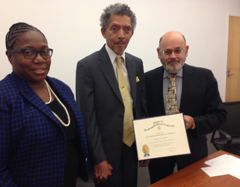 George Robert Carruthers is the recipient of Sigma Xi’s 2015 Walston Chubb Award for Innovation. He is an inventor, physicist, and space scientist.
George Robert Carruthers is the recipient of Sigma Xi’s 2015 Walston Chubb Award for Innovation. He is an inventor, physicist, and space scientist.
After joining the Naval Research Laboratory in 1964, Carruthers became a driving force in the use of ultraviolet astronomy to learn more about the universe. His most well-known contribution was developing the Apollo 16 far ultraviolet camera and spectrograph, which was designed specifically for use on the moon’s surface to record radiation from the upper half of the ultraviolet (UV) spectrum.
“What we had proposed to do was set up a camera on the surface of the moon to observe the Earth and study its hydrogen atmosphere, which extends out to many thousands of miles,” explains Carruthers. “Even the space station and the shuttle can’t get far enough away to really study the higher atmosphere.”
In 2003, Carruthers was inducted into the National Inventors Hall of Fame. In 2011, he was a recipient of the National Medal of Technology and Innovation. He has been a Sigma Xi member since 1969.
Invention Impact
A pioneer in ultraviolet astronomy, Carruthers’ invention was first used in sounding rocket flights in 1966, and made the first detection of molecular hydrogen in deep space during a 1970 flight. The camera used in the Apollo 16 mission produced about 200 photos revealing new features of Earth’s far-outer atmosphere, as well as deep-space objects from the perspective of the lunar surface.
Although the camera itself was left behind, a second version was used aboard the final Skylab flight in 1973 to obtain images of Comet Kohoutek. Carruthers has also been involved in numerous sounding rocket and space shuttle flights using his cameras, including far-UV studies of stars and nebulas, Comets Halley and West, and the Earth’s upper atmosphere. He also carried out an experiment on the unmanned DoD ARGOS satellite mission, launched in 1999.
Background
Carruthers was born in 1939 in Cincinnati, Ohio, but moved at age 12 to the south side of Chicago, Illinois. Even at a young age, Carruthers had an affinity towards astronomy and science, building his own telescopes and spending time at local science museums. He received a Bachelor of Science in aeronautical engineering, Masters in nuclear engineering, and doctorate in aeronautical and astronautical engineering from the University of Illinois.
Carruthers has also been involved in education and public outreach, including promoting science and technology among young African Americans.
Photo: George Carruthers, center, and his wife, Debra, on left, accepted his Walston Chubb Award for Innovation on December 9 at the University of Maryland from Sigma Xi president-elect Tee Guidotti.